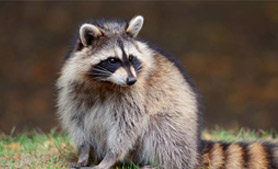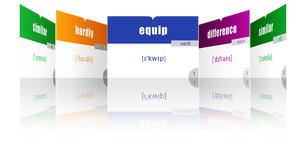Описане енота на английском языке
- Подробности
- 19082
 |
Прилагательные, описывающие Енота |
|
1 |
весёлый |
cheerful |
|
2 |
пушистый |
furry |
|
3 |
вороватый |
thievish |
|
4 |
задиристый |
pert |
|
5 |
нахальных |
impudent |
|
6 |
всеядный |
omnivorous |
|
7 |
симпатичный |
cute |
|
8 |
проворный |
prompt |
КРАТКОЕ ОПИСАНИЕ ЕНОТА:
|
Look at the picture. |
Посмотрите на картинку. |
|
You can see a raccoon. |
Вы можете видеть енота. |
|
It has pricked round ears. |
У него торчащие круглые уши. |
|
It has 2 black spots around its eyes. |
У него есть два круглых пятна вокруг его глаз. |
|
These black spots looks like a mask. |
Эти черные пятна похожи на маску. |
|
Its eyes are black. |
Глаза у него черные. |
|
It has a black nose with white sticking out whiskers. |
У него есть черный нос с белыми торчащими усами. |
|
It also has a thin black strip that goes from its nose to its forehead. |
У него также есть тонкая черная полоска, которая идет от (его) носа ко лбу. |
|
It has an elongated muzzle. |
У него удлиненная морда. |
|
Its body is covered with long and dense fur. |
Его тело покрыто длинным и плотным мехом. |
|
It has short legs. |
У него короткие ноги. |
|
It has a long, furry and ringed tail. |
У него длинный пушистый хвост с кольцами. |
|
It looks cute. |
Он выглядит мило. |
|
Raccoons are fast and playful. |
Еноты быстрые и игривые. |
Общая информация о еноте:
Look at the picture. You can see a raccoon. The raccoon (Latin: Procyon) also known as the "Common Raccoon" or "North American Raccoon" is a medium-sized predatory (1) mammal.
It has pricked round ears. The most characteristic (2) physical feature (3) of the raccoon is the area of black fur around its eyes, which contrasts sharply with the surrounding white face coloring. This black fur looks like a mask. Its eyes are black. At the end of its elongated muzzle there it has a black nose with white sticking out whiskers. There is also a thin black fur strip running from its nose to its forehead. Its body is covered with long stiff (4) guard-hairs and a dense (5) under-fur (6). It has short legs compared to its compact torso. This is the main reason why raccoons usually are not able to run quickly for long distances. It has a long furry ringed (7) tail.
The raccoon is the size of a large cat. Its average body length is 45-60 cm and tail is 20-25 cm. Its weight is 5 to 12 kg. Although, some specimens can reach up to 25 kg. Its paws have well developed fingers so that its paw-prints look like palm-prints of humans. Raccoons can grab (8) and hold objects with their front paws, as well as wash their food. The fur of the raccoon is thick (9) and brownish-gray.
Raccoons can climb trees very well. They have very dexterous (10) fingers that allow them to hang on branches, or climb down tree trunks (11) upside-down.
Thanks to its excellent night vision raccoons can move confidently even in almost complete darkness. Some raccoons can hibernate (12) for the winter season. They often sleep in large hollows with up to 10 raccoons that gather for hibernating. Although, in the southern regions raccoons often do not hibernate at all.
Raccoons are omnivorous (13). In spring and early summer, their main meal consists of animal food. In the second half of summer and in the autumn they prefer vegetable food. The main animal foods of the raccoon are insects and frogs and less often reptiles (snakes, lizards), crabs, fish, rodents and bird eggs. Racoon's vegetable food consists of berries, acorns, nuts and fruits. Before eating, the raccoon rinses (14) its food in water, hence (15) its Russian name, "poloskun".
Raccoons like mixed forests with old hollow (16) trees and the presence of ponds or swamps.
Raccoons have immunity to many infectious and invasive (17) diseases. However, one should be careful, since raccoons themselves can be "carriers" of serious infectious diseases.
This animal is active, very curious, pugnacious (18), bold (19) and cunning (20). In the USA and in many other countries raccoons are sometimes kept as house pets.
As a rule, raccoons live no more than 5 years in a wild. In captivity, they can live up to 20 years.
| Карточки PDF-1 PDF-2 |
Vocabulary (используйте карточки для слов, которые сложно запоминаются):
|
1 |
predatory [ˈpredətɔːri] |
хищный |
|
2 |
characteristic [ˌkærəktəˈrɪstɪk] |
характерный, типичный |
|
3 |
feature [ˈfiːtʃər] |
особенность, черта |
|
4 |
stiff [stɪf] |
жёсткий, крепкий; тугой |
|
5 |
dense [dens] |
плотный, густой |
|
6 |
underfur [ˈʌndərfɜːr] |
подшерсток |
|
7 |
ringed [rɪŋd] |
в кольцах |
|
8 |
grab [ɡræb] |
хватать |
|
9 |
thick [θɪk] |
густой |
|
10 |
dexterous [ˈdekstrəs] |
ловкий |
|
11 |
trunk [trʌŋk] |
ствол |
|
12 |
hibernate [ˈhaɪbərneɪt] |
зимовать |
|
13 |
omnivorous [ɑːmˈnɪvərəs] |
всеядный |
|
14 |
rinse [rɪns] |
полоскать |
|
15 |
hence [hens] |
в результате; отсюда |
|
16 |
hollow [ˈhɒləʊ] |
полый |
|
17 |
invasive [ɪnˈveɪsɪv] |
агрессивный, захватнический |
|
18 |
pugnacious [pʌɡˈneɪʃəs] |
драчливый |
|
19 |
bold [bəʊld] |
смелый, дерзкий, храбрый |
|
20 |
cunning [ˈkʌnɪŋ] |
хитрый, коварный, ловкий, искусный |







 Как правильно изучать английский язык по карточкам (статьи)
Как правильно изучать английский язык по карточкам (статьи)